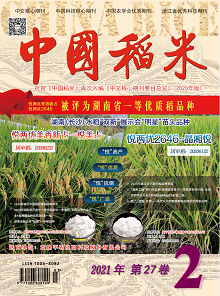With the national strong policy support, China’s rice area in 2020 reached 30 076 million hm2 after several years of decline, an increase of 382,000 hm2 from 2019. Affected by the severe occurrence of natural disasters, the average yield of rice in 2020 is 7 044.0 kg/hm2, which is 15.0 kg/hm2 lower than that in 2019, but it is still the second highest in history. The production of rice in 2020 reached 211.86 million tons, an increase of 2.25 million tons from 2019, and the total production of rice has stabilized at more than 200 million tons for 10 consecutive years. The domestic rice market prices keep rising, especially for the mid-late indica rice, whose price was much higher than that in 2019. In december 2020, the purchase price of mid-late indica rice was 2 740.3 yuan/t, a year-on-year increase of 9.0%. The prices of high-quality rice and common rice are totally different, the prices of high-quality rice such as Huanghuazhan and Fengliangyou are more than 0.2 yuan per kg higher than common varieties. The volume of rice imports increased again. In 2020, China imported 2.943 million tons of rice, an increase of 15.6% year-on-year; and exported 2.305 million tons of rice, decreased 16.1% from 2019. In 2020, the number of varieties approved continued to increase significantly, with more than 50% high quality rate for the national approved varieties, and the market structure was further optimized, the green technology in rice production revealed a momentum for rapid growth, pushing the green development in rice industry. In 2021, the rice area is expected to a slight increase from 2020, the yield is projected to be stable at 7 050.0 kg/hm2, the variety structure will continue to be optimized, the rice market will remain stable, and the promotion and application of green varieties and technologies will be accelerated.

